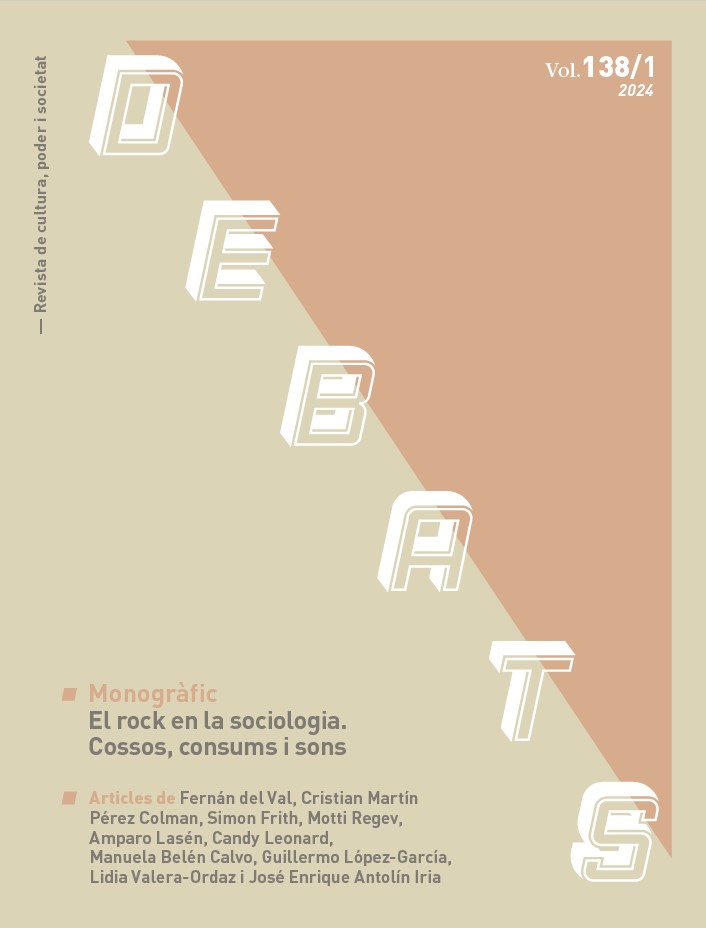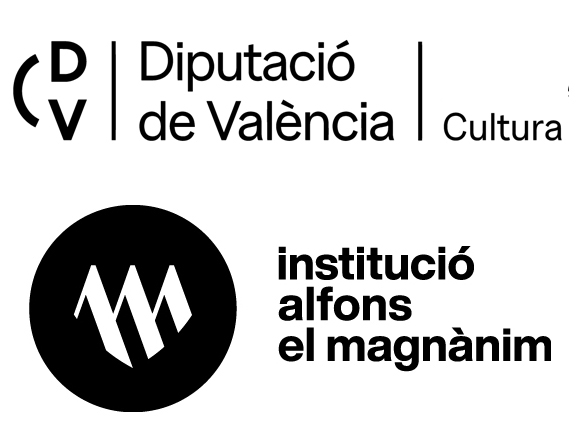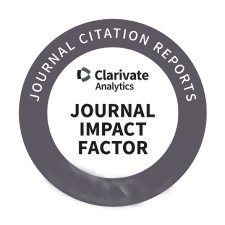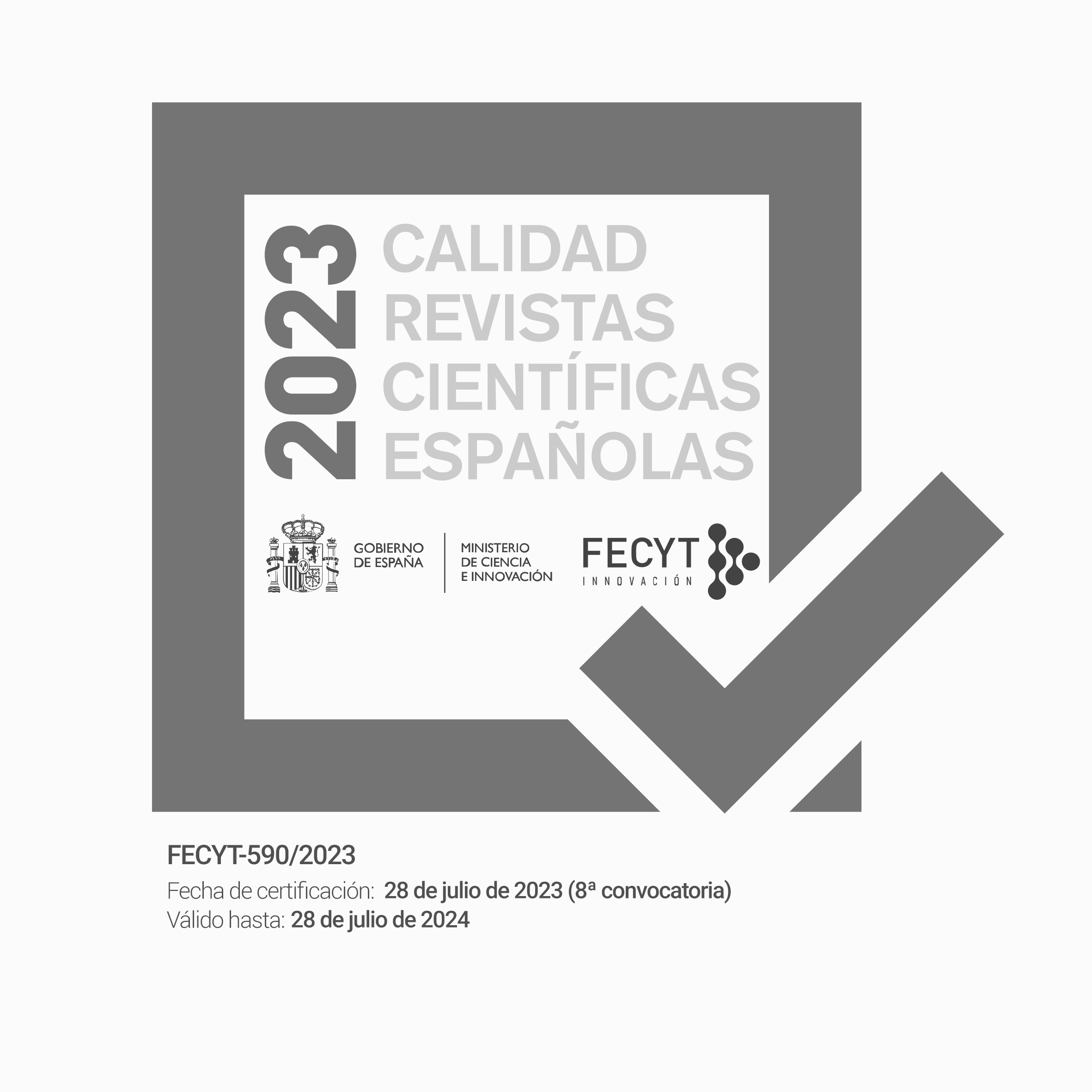The Post-media Public Sphere
DOI:
https://doi.org/10.28939/iam.debats-138-1.7Abstract
The public sphere is a concept that has undergone significant changes in recent decades. In its
traditional meaning, the public sphere was conceived as the exchange and communicative interaction
between social actors that gives rise to public opinion. But the development of media societies
gave rise to a public sphere colonized by the mass media, which were both intermediaries who
channeled the messages of these actors and privileged actors in the public conversation. The
article theoretically traces the evolution from the media public sphere of the second half of the
20th century to what we call the post-media public sphere, characterized by the fragmentation and
multiplicity of messages, actors and audiences, the rise of the Internet and digital
social networks, and the loss of the media’s capacity for intermediation and influence.
Downloads
References
Arendt, H. [1958] (1993). La condición humana. Barcelona: Paidós.
Arendt, H. (1996). Entre el pasado y el futuro. Ocho ejercicios sobre la reflexión política. Barcelona: Península.
Badillo, A., i Marenghi, P. (2001). De la democracia mediática a la democracia electrónica. Cuadernos de Información y Comunicación (CIC), 6, 39-61.
Bennett, W. L., i Iyengar, S. (2008). A new era of minimal effects? The changing foundations of political communication. Journal of Communication, 58(4), 707-731. https://doi.org/10.1111/j.1460-2466.2008.00410.x
Bennett, W. L., i Livingston, S. (2018). The disinformation order: disruptive communication and the decline of democratic institutions. European Journal of Communication, 33(2), 122-139. https://doi.org/10.1177/0267323118760317
Bennett W. L., i Pfetsch, B. (2018). Rethinking political communication in a time of disrupted public spheres. Journal of Communication, 68(2), 243-253. https://doi.org/10.1093/joc/jqx017
Bimber, B., i Gil de Zúñiga, H. (2022). The unedited public sphere. New Media & Society, 22(4), 700-715. https://doi.org/10.1177/146144481989398
Blekesaune, A., Elvestad, E., i Aalberg, T. (2012). Tuning out the world of news and current affairs. An empirical study of Europe’s disconnected citizens. European Sociological Review, 28, 110-126. https://doi.org/10.1093/esr/jcq051
Bobbio, N. (1984). The future of democracy. Minnesota: The University of Minnesota Press.
Bourdieu, P. (1996). Sobre la televisión. Barcelona: Anagrama.
Brandtzaeg, P. B., Chaparro Domínguez, M. A, i Følstad, A. (2017, octubre 18-21). Context Collapse in News. Article presentat en congrés. Recuperat de: http://spir.aoir.org.
Casero, A. (2012). El periodismo político: algunas características definitorias. En A. Casero, (ed.), Periodismo político en España: concepciones, tensiones y elecciones (19-46). La Laguna: Sociedad Latina de Comunicación Social.
Castells, M. (2009). Comunicación y poder. Madrid: Alianza Editorial.
Cooke, N. A. (2018). Fake news and alternative facts: Information literacy in a post-truth era. Chicago: ALA Editions.
Crespi, I. (2000). El proceso de opinión pública. Barcelona: Ariel.
Dader, J. L. (1992). El periodista en el espacio público. Barcelona: Bosch.
Dader, J. L. (2012). Periodismo político y política del periodismo: Imaginando un futuro digno y sostenible. En S. Berrocal i E. Campos Domínguez (eds.), La investigación en periodismo político en el entorno de los nuevos medios de comunicación (35-58). Madrid: SEP.
Davis, R. (2005). Politics Online: Blogs, Chatrooms, and Discussion Groups in American Democracy. Nova York: Routledge.
Davis, R. (2009). Typing Politics: The Role of Blogs in American Politics. Nova York: Oxford University Press. Dylko, I., Dolgov, I., Hoffman, W., Eckhart, N., Molina, M., i Aaziz, O. (2018). Impact of customizability technology on political polarization. Journal of Information Technology & Politics, 15(1), 19-33. http://doi.org/10.1080/193 31681.2017.1354243
Esser, F., de Vreese, C. H., Strömback, J., Van Aelst, P., Aalberg, T., Stanyer, J., et al. (2012). Political information opportunities in Europe: A longitudinal and comparative study of thirteen television systems. The International Journal of Press/Politics, 17(3), 247-274. https://doi.org/10.1177/1940161212442956
Farrell, H., Lawrence, E., i Sides, J. (2008). Self-Segregation or Deliberation? Blog Readership, Participation and Polarization in American Politics. Article presentat en conferència.
Fisher, M. (2016). Realismo capitalista: ¿No hay alternativa? Buenos Aires: Caja Negra.
Flew, T. (2019). Digital communication, the crisis of trust, and the post-global. Communication Research and Practice, 5(1), 4-22. https://doi.org/10.1080/22041451.2019.1561394
Gil de Zúñiga, H., i Cheng, Z. (2021). Origin and evolution of the News Finds Me perception: Review of theory and effects. Profesional de la información, 30(3), e300321. https://doi.org/10.3145/epi.2021.may.21
Gil de Zúñiga, H., i Diehl, T. (2019). News finds me perception and democracy: Effects on political knowledge, political interest, and voting. New media & society, 21(6), 1253-1271. https://doi.org/10.1177/1461444818817548
Grossi, G. (2007). La opinión pública. Teoría del campo demoscópico. Madrid: CIS.
Habermas, J. [1962] (1997). Historia y crítica de la opinión pública: La transformación estructural de la vida pública. Barcelona: Gustavo Gili.
Habermas, J. (1999). Teoría de la acción comunicativa (2 vols.). Madrid: Taurus.
Hall, S. (1973). Encoding and decoding in the television discourse. En S. During (ed.), The Cultural Studies Reader. Londres: Routledge, 90-103.
Hallin, D., i Mancini, P. (2004). Sistemas mediáticos comparados: Tres modelos de relación entre los medios de comunicación y la política. Barcelona: Hacer.
Hallin, D., i Mancini, P. (2017). Ten Years After Comparing Media Systems: What Have We Learned? Political Communication, 34(2), 155-171. https://doi.org/10.1080/10584609.2016.1233158
Han, B. (2022). Infocracia. La digitalización y la crisis de la democracia. Madrid: Taurus.
Huckfeldt, R., Johnson, P. E., i Sprague, J. (2004). Political disagreement: The survival of diverse opinions within communication networks. Nova York: Cambridge University Press.
Ksiazek, T. B., Malthouse, E. C., i Webster, J. G. (2010). News-seekers and avoiders: exploring patterns of total news consumption across media and the relationship to civic participation. Journal of Broadcasting & Electronic Media, 54(4), 551-568. https://doi.org/10.1080/08838151.2010.519808
Lazarsfeld, P. F., i Merton, R. K. (1948). Mass communication, popular taste and organized social action. En L. Bryson (ed.), The Communication of Ideas (95-118). Nova York: Harper and Brothers.
Lee, S. (2020). Probing the mechanisms through which social media erodes political knowledge: the role of the news-finds-me perception. Mass Communication & Society, 23(6), 810-832. https://doi.org/10.1080/15205436.2020.1821381
Levendusky, M. (2013). Partisan media exposure and attitudes towards the opposition. Political Communication, 30(4), 565-581. https://doi.org/10.1080/10584609.2012.737435
Lévy, P. (2002). Ciberdemocracia. Ensayo sobre filosofía política. Barcelona: Editorial UOC.
Levy, D., i Nielsen, R. K. (eds.) (2010). The Changing Business of Journalism and its Implications for Democracy. Londres: RIJS.
López-García, G. (2006). Comunicación en red y mutaciones de la esfera pública. Zer, 20, 231-249. https://doi.org/10.1387/zer.3762
López-García, G. (2017). La comunicación política y los discursos sobre el poder. El Profesional de la Información, 26(4), 573-578. https://doi.org/10.3145/epi.2017.jul.01
López-García, Gamir, J., i Valera L. (2018). Comunicación política. Teorías y enfoques. Madrid: Síntesis.
Manin, B. (1997). The Principles of Representative Government. Nova York: Cambridge University Press.
Margolis, M., i Resnick, D. (2000). Politics as usual: The «cyberspace revolution». Thousand Oaks: Sage.
Masip, P., Ruiz-Caballero, C., i Suau, J. (2019). Active audiences and social discussion on the digital public sphere. Profesional de la información, 28(2). https://doi.org/10.3145/epi.2019.mar.04
Mazzoleni, G., i Schulz, W. (1999). Mediatization of Politics: A Challenge for Democracy? Political Communication, 16, 247-261. https://doi.org/10.1080/105846099198613
McLuhan, M. [1964] (1996). Comprender los medios de comunicación. Las extensiones del ser humano. Barcelona: Paidós.
Monzón, C. (1996). Opinión pública, comunicación y política. La formación del espacio público. Madrid: Tecnos.
Morozov, E. (2013). To Save Everything, Click Here: The Folly of Technological Solutionism. Nova York: Public Affairs.
Mullainathan, S., i Shleifer, A. (2005). The market for news. American Economic Review, 95(4), 1031-1053. https://www.jstor.org/stable/4132704
Muñoz Alonso, A., Rospir, J. I., Monzón, C., i Dader, J. L. (1992). Opinión pública y comunicación política. Madrid: Eudema.
Ortega, F. (2011). La política mediatizada. Madrid: Alianza Editorial.
Palau-Sampio, D. (2021). Sponsored content in Spanish media: strategies, transparency, and ethical concerns. Digital Journalism, 9(7), 908-928. https://doi.org/10.1080/21670811.2021.1966314
Palau-Sampio, D., i López-García, G. (2022). Communication and crisis in the public space: Dissolution and uncertainty. Profesional de la Información, 31(3). https://doi.org/10.3145/epi.2022.may.16
Pariser, E. (2011.) The filter bubble: What the internet is hiding from you. Londres: Penguin.
Perrineau, P. (ed.) (2003). Le désenchantement démocratique. La Tour d’Aigues: Editions de l’Aube.
Precht, R. D (2010). Die Kunst kein Egoist zu sein: Warum wir gerne gut sein wollen und was uns davon abhält. Múnic: Goldmann Verlag.
Price, V. (1994). La opinión pública. Barcelona: Paidós.
Prior, M. (2005). News vs. Entertainment: How Increasing Media Choice Widens Gaps in Political Knowledge and Turnout. American Journal of Political Science, 49(3), 577-592. https://doi.org/10.1111/j.1540-5907.2005.00143.x
Prior, M. (2007). Post-Broadcast Democracy: How Media Choice Increases Inequality in Political Involvement and Polarizes Elections. Cambridge: Cambridge University Press. Reuters Institute (2022). Digital News Report 2022. Cambridge University Press. Disponible en: https://reutersinstitute.politics.ox.ac.uk/es/digital-news-report/2022/dnr-resumen-ejecutivo.
Rheingold, H. (2002). Multitudes inteligentes: la próxima revolución social. Barcelona: Gedisa.
Sampedro, V. (2000). Opinión pública y democracia deliberativa. Medios, sondeos y urnas. Madrid: Istmo.
Schlesinger, P. (2020). After the post-public sphere. Media, Culture & Society, 42(7), 1545-1563. https://doi.org/10.1177/0163443720948003
Steppat, D., Castro Herrero, L., i Esser, F. (2022). Selective exposure in different political information environments: How media fragmentation and polarization shape congruent news use. European Journal of Communication, 37(1), 82-102. https://doi.org/10.1177/02673231211012141
Stroud, N. J. (2008). Media use and political predispositions: Revisiting the concept of selective exposure. Political Behavior, 30(3), 341-366. https://www.jstor.org/stable/40213321
Stroud, N. J. (2010). Polarization and partisan selective exposure. Journal of Communication, 60(3), 556-576. https://doi.org/10.1111/j.1460-2466.2010.01497.x
Sunstein, C. (2001). República.com: Internet, democracia y libertad. Barcelona: Paidós.
Swanson, D. (1995). El campo de la comunicación política. La democracia centrada en los medios. En A. Muñoz Alonso, i J. I. Rospir (eds.), Comunicación política. Madrid: Universitas.
Thompson, John B. (1998). Los media y la modernidad. Una teoría de los medios de comunicación. Barcelona: Paidós.
Valentino, N. A., Banks, A. J., Hutchings, V. L., i Davis, A. K. (2009). Selective exposure in the Internet age: The interaction between anxiety and information utility. Political Psychology, 30(4), 591-613. https://www.jstor.org/stable/25655419
Valera-Ordaz, L. (2019). Frame building and frame sponsorship in the 2011 Spanish election: the practices of polarised pluralism. Contemporary Social Science, 14(1), 114-131. https://doi.org/10.1080/21582041.2017.1347703
Valera-Ordaz, L., Carratalá, A., i Palau Sampio, D. (2017). La batalla de los partidos por la definición de la realidad: Los marcos partidistas durante las elecciones generales de 2015. En G. López García i L. Valera-Ordaz (eds.), Pantallas electorales: el discurso de partidos, medios y ciudadanos en la campaña de 2015 (59-78). Barcelona: Editorial UOC.
Valera-Ordaz, L., Requena i Mora, M., Calvo, D., i López-García, G. (2022). Desenredando la desinformación: Nociones y discursos de la población española. Comunicar: Revista científica iberoamericana de comunicación y educación, (72), 21-32. https://doi.org/10.3916/C72-2022-02
Van Aelst, P., Strömbäck, J., Aalberg, T., Esser, F., De Vreese, C., Matthes, J., et al. (2017). Political communication in a high-choice media environment: a challenge for democracy? Annals of the International Communication Association, 41(1), 3-27. https://doi.org/10.1080/23808985.2017.1288551
Waisbord, S. (2018). The elective affinity between post-truth communication and populist politics. Communication Research and Practice, 4(1), 17-34. https://doi.org/10.1080/22041451.2018.1428928
Wolton, D. (1992). Elogio del gran público: una teoría crítica de la televisión. Barcelona: Gedisa.
Wolton, D. (2000). Internet: ¿y después? Barcelona: Gedisa.
Zaller, J. (1992). The Nature and Origins of Mass Opinion. Nova York: Cambridge University Press.
Downloads
Published
How to Cite
Issue
Section
License
Without prejudice to the provisions of article 52 of Spanish Law 22/1987 of November 11 on Intellectual Property, BOE (official state bulletin) of November 17, 1987, and pursuant to said legislation, the author(s) surrender(s) free of charge its rights of edition, publication, distribution and sale of the article, for its publication in Debats. Journal on Culture, Power and Society.
Debats. Journal on Culture, Power and Society is published under the Creative Commons license system in accordance with the «Recognition - Non-Commercial (by-nc) modality: The generation of derivative works is permitted provided that commercial use is not made. Nor can the original work be used for commercial purposes».
Thus, when the author submits his/her contribution, he/she explicitly accepts this assignment of publishing and publishing rights. Authors also authorize Debats. Journal on Culture, Power and Society to include their work in an issue of the journal to be distributed and sold.











